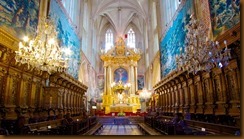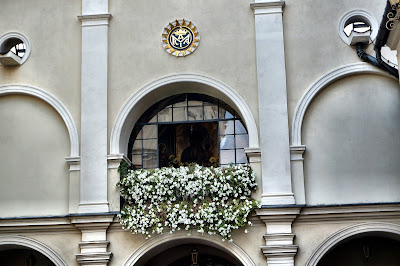Today’s itinerary included a morning tour of Krakow. In the afternoon we visited Auschwitz and Birkenau concentration camps.
Krakow was the old capital of Poland until the capital was moved to Warsaw in late 16th century. Krakow remains Poland’s center of culture, heritage, and academia. It was one of the few Polish cities that were saved from major destruction during many wars which devastated the country, including both World Wars. During WWII the city was not damaged as much as Warsaw and was able to bounce back from devastation quickly after the war. Today Krakow is a major tourist attraction. It attracts far more tourists than the capital Warsaw. The medieval part of Krakow and the adjacent Wawel Hill are designated as a UNESCO World Heritage Site.
This morning we started our tour by visiting Krakow’s Jewish quarter. During Nazi Germany’s occupation, the city’s sizable Jewish population was expelled from its historic quarter and sent to a ghetto. After the war was over, there were not many Jews left to return to the quarter.
This Old Synagogue is a Renaissance building. The brick building in the back was built in the 15th century. The front building with zagged rooflines was built in the 16th century.
(Click on each picture to get the full-size view)
In front of the synagogue is a long plaza lined with Jewish restaurants, stores, and offices.
There is a beauty shop named Rubinstein, from which Helena Rubinstein allegedly got her start. The rivalry between her and Elizabeth Arden for the supremacy of the cosmetic market was legendary.
It rained all day on this day. It made taking photographs difficult.
Next stop is the Schindler’s factory, made famous by Steven Spielberg’s movie “Schindler’s List”. http://www.imdb.com/title/tt0108052/
We passed by the colorful St. Joseph’s Church, in Gothic Revival style.
On the ground of the Royal Castle at Wawel Hill.
Denise took this picture for us with her husband Steve. The friendly couple is from Indiana.
Wawel Cathedral, aka Krakow Cathedral, was home to royal coronations and served as the resting place for many national heroes. It is regarded as Poland's national sanctuary
The Krakow Cathedral is the most prominent and historic building in Krakow. This cathedral has been rebuilt three times. Different parts of the building are from different periods. Its baroque spire is from the 18th century.
We went inside the cathedral but were not allowed to take photographs. I copied this picture from the internet to remind me how the inside of the cathedral looks.

The Renaissance-style Castle Courtyard, inside the Royal Castle, is very beautiful and imposing.
Wawel Hill has tall fortification walls, and watchtowers (not seen in this picture)
Pope John Paul II was the Krakow bishop, then cardinal, before his appointment as the first non-Italian Pope in over 400 years.
Church of St. Andrew with its two spires. It is considered the best-preserved example of Romanesque architecture in Krakow
The townhouses along this street, one of the oldest in Krakow, used to be palaces. Now they are used for fancy shops. Church of St. Andrew is in the distance.
On the fashionable old street stands this Dominican Church with spiky façade.
A sweet shop with colorful candies.
A doughnut shop with a friendly staff.
We then came to the Market Square. It is the largest medieval European square, covering roughly 40,000 square meters. At one corner of the square is St. Mary’s Basilica, with its two asymmetric towers.
We bought the tickets to go inside the basilica. This is the view of the altar.
There requires a separate ticket to go up the church tower. This is the view from the top of the tower (copied from the internet). It shows the square in its entirety, with Cloth Hall in the middle of the square, and the Town Hall Tower behind it.

Inside the Cloth Hall are stalls selling various trinkets to tourists.
Behind St. Mary’s Basilica is the modest Church of St. Barbara
Our afternoon trip to Auschwitz and Birkenau was a somber one. The genocide and cruelty committed in these two camps were inexcusable and mind-boggling. It was very difficult to comprehend the cold-hearted mentality that ever conceived such atrocity and inhumanity. I felt speechless and sad. With a heavy heart, I thank Gate 1 for arranging a learning lesson in human dignity and fragility.
Entrance to Auschwitz.
Barracks that housed prisoners at Auschwitz.
Statistics at Auschwitz
It was a short drive from Auschwitz to Birkenau. Prisoners arrived on the train passing through the Gate of Hell. They were sorted immediately. The able bodies were sent to the labor camp; the rest to gas chambers.
Behind the trees were two crematories that burned thousands of body each day at Birkenau. Nazis destroyed the crematories before the Soviet troop arrived and liberated the camp.
The restaurant our tour director recommended for dinner was too busy so we went somewhere else. It was a raining evening and there were not many people around the Market Square, We randomly picked a place, Loza, that seemed to have more customers. Food was passable, not memorable. https://www.yelp.com/biz/lo%C5%BCa-krak%C3%B3w?search_key=50384
Each evening, our tireless and ever-enthusiastic tour director Neira would post a daily itinerary in the hotel lobby. This is a sample.
Krakow, a charismatic city from the medieval time,
Wawel Castle, a fortification with unparalleled charm.
Poland’s center of heritage, academia, and culture,
"A World Heritage" proclaimed UNESCO.
-Joe
Auschwitz, an extermination site of the holocaust,
Birkenau, its brutal and brazen cohost.
The massacre brought unfathomable havoc,
It made me sick to my stomach.


































































